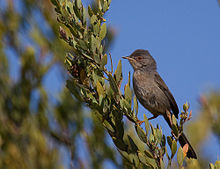- Dartford Warbler
-
Dartford Warbler 
Female in Spain Conservation status Scientific classification Kingdom: Animalia Phylum: Chordata Class: Aves Subclass: Neornithes Infraclass: Neognathae Superorder: Neoaves Order: Passeriformes Suborder: Passeri Infraorder: Passerida Superfamily: Sylvioidea Family: Sylviidae Genus: Sylvia Species: S. undata Binomial name Sylvia undata
(Boddaert, 1783)The Dartford Warbler, Sylvia undata, is a typical warbler from the warmer parts of western Europe, and northwestern Africa. Its breeding range lies west of a line from southern England to the heel of Italy (southern Apulia). The Dartford Warbler is usually resident all-year in its breeding range, but there is some limited migration.
Contents
Description and systematics
Like many typical warblers, this small (13 cm) passerine bird has distinct male and female plumages. The song is a distinctive rattling warble. The plumage of the species is unobtrusive and muted tones, distinguished by its long tail compared with that of other warblers, the colors are adapted to this of dry dead plants, old wood or sunny greyish wood on their habitats. It is almost invisible standing on Mediterranean shrubs.
The male of this small Sylvia has a grey back and head, reddish underparts, and a red eye (see below for photo). The reddish throat is spotted with white. In some populations the male has the plumage that covers head and back of a dark bluish gray color off, like slate or brownish tone. Underneath the bottom of this warbler is auburn brown or pink salmon also off, the throat is speckled with white spots and the sides are a dull grayish tone, being more clear about the abdomen.
The female is paler below, especially on the throat, and a browner grey below. The female also muted in color is brown above and lighter below, with the head and the back in gray-brown. Underparts sometimes pink or a pale red. The female also has white spots, although they are smaller and less marked.
In the immature or juveniles can not identify the sex, and are similar to females.
The type locality is the Provence in France. The Dartford Warbler probably forms a superspecies with Tristram's Warbler and this in turn seems close to Marmora's Warbler and the Balearic Warbler.[1] Altogether, this group of typical warblers bears an uncanny resemblance to the Wrentit, the only species of Sylviidae from the Americas (compare Wrentit with Dartford Warbler photo linked below). Still, the Wrentit is less closely related to the genus Sylvia than to the parrotbills.[2] Its visual similarity to the Dartford Warbler group is an astounding example of convergent evolution between birds closely related enough to already share many similarities evolving half a world apart in similar Mediterranean scrub habitat.
Ecology and status
This small "warbler" species breeds in heathlands, sometimes near coasts, with gorse bushes for nesting. Like its relatives, the Dartford Warbler is insectivorous, but will also take berries. The nest is built in low shrub, and 3-6 eggs are laid. It inhabits open fields with Jara and degraded scrub brush. Common in heather. In winter may be coming to urban solitary areas, but always it find shrubs in these areas. This shy warblers avoiding to the people. Nests in bushes with thorns and near the ground.
The species is naturally rare. The largest european populations of Sylvia undata focus on Iberian peninsula, and less in large part of France in Italy and southern England. In Africa can be found only in small areas in the north, being present as wintering in northern Morocco and northern Algeria. These warblers are mostly insectivore, feeding caterpillars, butterflys, beetles, Spiders and larvas, etc.
Dartford Warblers are named for Dartford Heath in north west Kent, where the population became extinct in the early 20th century. They almost died out in the United Kingdom in the severe winter of 1962/1963 when the national population dropped to just 10 pairs. However, this species can recover well in good quality habitat, thanks to repeated nesting and a high survival rate for the young. Indeed they recovered in some areas of the UK, but numbers are once again on the decline in other regions of that country, as well as elsewhere.
Formerly classified as a 'Species of Least Concern' by the IUCN,[3] it was suspected to be rarer than generally assumed. Following the investigation of the apparent decline this was confirmed, and the Dartford Warbler was consequently uplisted to Near Threatened status in 2008.[4]
Sub-species
- Sylvia undata dartfordiensis (south England and north-west France)
- Sylvia undata toni (north-west Africa)
- Sylvia undata undata (Iberian Peninsula and south France)
- Sylvia undata aremorica
- Sylvia undata naevalbens
Footnotes
References
- BirdLife International (BLI) (2004). Sylvia undata. 2006. IUCN Red List of Threatened Species. IUCN 2006. www.iucnredlist.org. Retrieved on 9 May 2006.
- BirdLife International (BLI) (2008): 2008 IUCN Redlist status changes. Retrieved 2008-MAY-23.
- Cibois, Alice (2003): Mitochondrial DNA Phylogeny of Babblers (Timaliidae). Auk 120(1): 1-20. DOI: 10.1642/0004-8038(2003)120[0035:MDPOBT]2.0.CO;2 HTML fulltext without images
- Helbig, A.J. (2001): Phylogeny and biogeography of the genus Sylvia. In: Shirihai, Hadoram: Sylvia warblers: 24-29. Princeton University Press, Princeton, N.J. ISBN 0691088330
- Jønsson, Knud A. & Fjeldså, Jon (2006): A phylogenetic supertree of oscine passerine birds (Aves: Passeri). Zool. Scripta 35(2): 149–186. doi::10.1111/j.1463-6409.2006.00221.x (HTML abstract)
- Pasquet, Eric; Bourdon, Estelle; Kalyakin, Mikhail V. & Cibois, Alice (2006). The fulvettas (Alcippe), Timaliidae, Aves): a polyphyletic group. Zoologica Scripta 35, 559–566. doi:10.1111/j.1463-6409.2006.00253.x (HTML abstract)
External links
- Avibase
- Chelmarsh Ringing Group: Photo of hand-held Dartford Warbler. Retrieved 2007-APR-26.
- Ageing and sexing (PDF) by Javier Blasco-Zumeta
Categories:- IUCN Red List near threatened species
- Sylvia
- Birds of Europe
Wikimedia Foundation. 2010.

